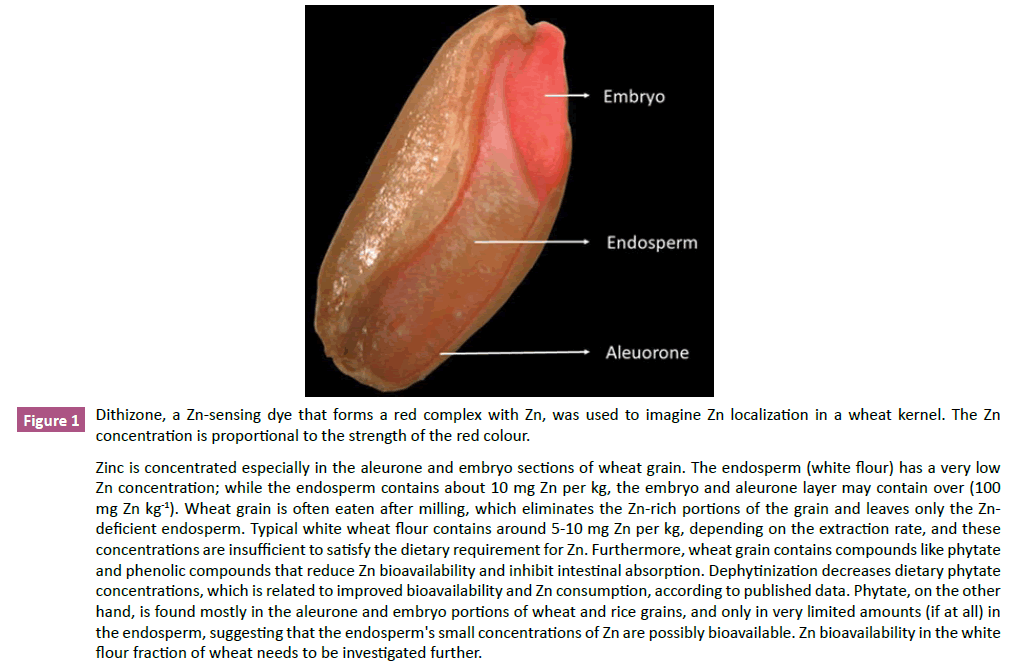Bioavailability and Localization of Zn in wheat grain
M. Morgan
DOI10.36648/ipctn.21.06.5
M. Morgan*
Editorial Office, iMed Publications, London, UK
- Corresponding Author:
- M. Morgan
Editorial Office
iMed Publications
London, UK
E-mail: morgano_jl@hotmail.com
Received date: January 16, 2021; Accepted date: February 05, 2021; Published date: February 13, 2021
Citation: Morgan M (2021) Bioavailability and Localization of Zn in wheat grain. J Nutraceuticals Food Sci Vol.6 No.2:5.
Abstract
Zinc is concentrated especially in the aleurone and embryo sections of wheat grain. The endosperm (white flour) has a very low Zn concentration; while the endosperm contains about 10 mg Zn per kg, the embryo and aleurone layer may contain over 100 mg Zn kg1. Wheat grain is often eaten after milling, which eliminates the Zn-rich portions of the grain and leaves only the Zn-deficient endosperm. Typical white wheat flour contains around 5–10 mg Zn per kg, depending on the extraction rate, and these concentrations are insufficient to satisfy the dietary requirement for Zn. Furthermore, wheat grain contains compounds like phytate and phenolic compounds that reduce Zn bioavailability and inhibit intestinal absorption.
Figure 1: Dithizone, a Zn-sensing dye that forms a red complex with Zn, was used to imagine Zn localization in a wheat kernel. The Zn concentration is proportional to the strength of the red colour.
Zinc is concentrated especially in the aleurone and embryo sections of wheat grain. The endosperm (white flour) has a very low Zn concentration; while the endosperm contains about 10 mg Zn per kg, the embryo and aleurone layer may contain over (100 mg Zn kg-1). Wheat grain is often eaten after milling, which eliminates the Zn-rich portions of the grain and leaves only the Zndeficient endosperm. Typical white wheat flour contains around 5-10 mg Zn per kg, depending on the extraction rate, and these concentrations are insufficient to satisfy the dietary requirement for Zn. Furthermore, wheat grain contains compounds like phytate and phenolic compounds that reduce Zn bioavailability and inhibit intestinal absorption. Dephytinization decreases dietary phytate concentrations, which is related to improved bioavailability and Zn consumption, according to published data. Phytate, on the other hand, is found mostly in the aleurone and embryo portions of wheat and rice grains, and only in very limited amounts (if at all) in the endosperm, suggesting that the endosperm's small concentrations of Zn are possibly bioavailable. Zn bioavailability in the white flour fraction of wheat needs to be investigated further.
References
- Cakmak I, Kutman U B (2017) Agronomic biofortification of cereals with zinc: a review. Wiley online lib.
Open Access Journals
- Aquaculture & Veterinary Science
- Chemistry & Chemical Sciences
- Clinical Sciences
- Engineering
- General Science
- Genetics & Molecular Biology
- Health Care & Nursing
- Immunology & Microbiology
- Materials Science
- Mathematics & Physics
- Medical Sciences
- Neurology & Psychiatry
- Oncology & Cancer Science
- Pharmaceutical Sciences

